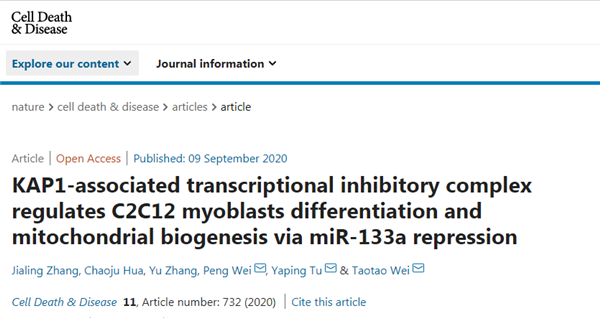Home> Science Outreach
Research groups explain function of the transcriptional regulatory mechanism of miR-133a in cell differentiation
Updated: 2020-09-17

The paper published in the journal Cell Death & Disease. [Photo/nature.com]
An important paper co-authored by a group led by Wei Taotao, a researcher from the Institute of Biophysics (IBP) at the Chinese Academy of Sciences and a group led by Tu Yaping, a professor from the School of Medicine at Creighton University, was published in the international academic journal Cell Death & Disease on Sept 9.
The research paper -- entitled "KAP1-associated transcriptional inhibitory complex regulates C2C12 myoblasts differentiation and mitochondrial biogenesis via miR-133a repression" -- marked more achievements made by the Chinese team.
Researchers found that the upregulated expression of miR-133a can induce the biogenesis of mitochondria and the differentiation of myoblasts. They also utilized the technology of CAPTURE to ascertain the regulatory role of KAP1 in the upstream region in the expression of miR-133a, further deepening their understanding of the transcriptional and regulatory mechanism of miR-133a, together with its function.
Given the important function of miR-133a in physiology and pathophysiology, the exploration of its regulatory mechanism will provide important clues to the treatment of pulmonary fibrosis and other related diseases.
Moreover, the Wei and Tu teams took the dynamic expression of miR-133a in the differentiation of myoblasts as a model. They utilized CRISPR/Cas9-based capture technique and combined the methods of high-throughput sequencing and bioinformatics, to analyze the regulatory mechanism of miR-133a expression.
The researchers found that KAP1-associated transcriptional complex accounts for the suppression of miR-133a in C2C12 myoblasts.
They found that the knockdown of KAP1 will increase the expression of miR-133a, which occurs in parallel to the biogenesis of mitochondria and the differentiation of C2C12 myoblasts.
The upregulation of miR-133a can induce the biogenesis of mitochondria and the differentiation of C2C12 myoblasts, whereas the miR-133a inhibitor can significantly deter cell differentiation.
It is the first study that has utilized the capture technique to identify the regulatory factors of miR-133a during cell differentiation, which provides new ideas for probing into the precision regulatory machinery of miRNAs during different biological processes.
